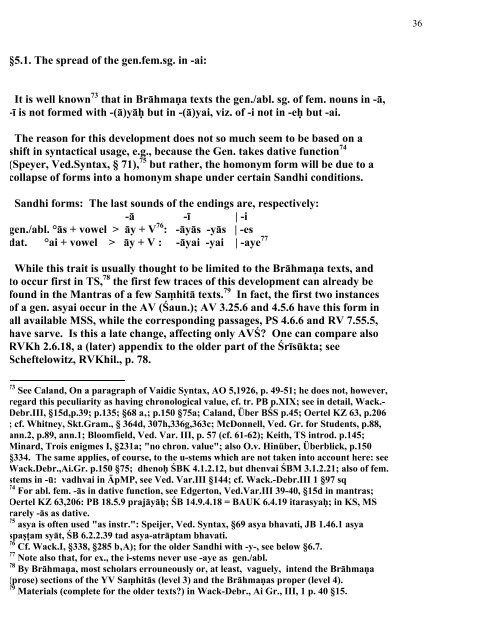TRACING VEDIC DIALECTS - People.fas.harvard.edu
TRACING VEDIC DIALECTS - People.fas.harvard.edu
TRACING VEDIC DIALECTS - People.fas.harvard.edu
Create successful ePaper yourself
Turn your PDF publications into a flip-book with our unique Google optimized e-Paper software.
§5.1. The spread of the gen.fem.sg. in -ai:<br />
It is well known 73 that in Brāhmaṇa texts the gen./abl. sg. of fem. nouns in -ā,<br />
-ī is not formed with -(ā)yāḥ but in -(ā)yai, viz. of -i not in -eḥ but -ai.<br />
The reason for this development does not so much seem to be based on a<br />
shift in syntactical usage, e.g., because the Gen. takes dative function 74<br />
(Speyer, Ved.Syntax, § 71), 75 but rather, the homonym form will be due to a<br />
collapse of forms into a homonym shape under certain Sandhi conditions.<br />
Sandhi forms: The last sounds of the endings are, respectively:<br />
-ā -ī | -i<br />
gen./abl. °ās + vowel > āy + V 76 : -āyās -yās | -es<br />
dat. °ai + vowel > āy + V : -āyai -yai | -aye 77<br />
While this trait is usually thought to be limited to the Brāhmaṇa texts, and<br />
to occur first in TS, 78 the first few traces of this development can already be<br />
found in the Mantras of a few Saṃhitā texts. 79 In fact, the first two instances<br />
of a gen. asyai occur in the AV (Śaun.); AV 3.25.6 and 4.5.6 have this form in<br />
all available MSS, while the corresponding passages, PS 4.6.6 and RV 7.55.5,<br />
have sarve. Is this a late change, affecting only AVŚ? One can compare also<br />
RVKh 2.6.18, a (later) appendix to the older part of the Śrīsūkta; see<br />
Scheftelowitz, RVKhil., p. 78.<br />
73 See Caland, On a paragraph of Vaidic Syntax, AO 5,1926, p. 49-51; he does not, however,<br />
regard this peculiarity as having chronological value, cf. tr. PB p.XIX; see in detail, Wack.-<br />
Debr.III, §15d,p.39; p.135; §68 a‚; p.150 §75a; Caland, Über BŚS p.45; Oertel KZ 63, p.206<br />
; cf. Whitney, Skt.Gram., § 364d, 307h,336g,363c; McDonnell, Ved. Gr. for Students, p.88,<br />
ann.2, p.89, ann.1; Bloomfield, Ved. Var. III, p. 57 (cf. 61-62); Keith, TS introd. p.145;<br />
Minard, Trois enigmes I, §231a; "no chron. value"; also O.v. Hinüber, Überblick, p.150<br />
§334. The same applies, of course, to the u-stems which are not taken into account here: see<br />
Wack.Debr.,Ai.Gr. p.150 §75; dhenoḥ ŚBK 4.1.2.12, but dhenvai ŚBM 3.1.2.21; also of fem.<br />
stems in -ū: vadhvai in ĀpMP, see Ved. Var.III §144; cf. Wack.-Debr.III 1 §97 sq<br />
74 For abl. fem. -ās in dative function, see Edgerton, Ved.Var.III 39-40, §15d in mantras;<br />
Oertel KZ 63,206: PB 18.5.9 prajāyāḥ; ŚB 14.9.4.18 = BAUK 6.4.19 itarasyaḥ; in KS, MS<br />
rarely -ās as dative.<br />
75 asya is often used "as instr.": Speijer, Ved. Syntax, §69 asya bhavati, JB 1.46.1 asya<br />
spaṣṭam syāt, ŚB 6.2.2.39 tad asya-atrāptam bhavati.<br />
76 Cf. Wack.I, §338, §285 b‚A); for the older Sandhi with -y-, see below §6.7.<br />
77 Note also that, for ex., the i-stems never use -aye as gen./abl.<br />
78 By Brāhmaṇa, most scholars errouneously or, at least, vaguely, intend the Brāhmaṇa<br />
(prose) sections of the YV Saṃhitās (level 3) and the Brāhmaṇas proper (level 4).<br />
79 Materials (complete for the older texts?) in Wack-Debr., Ai Gr., III, 1 p. 40 §15.<br />
36
















